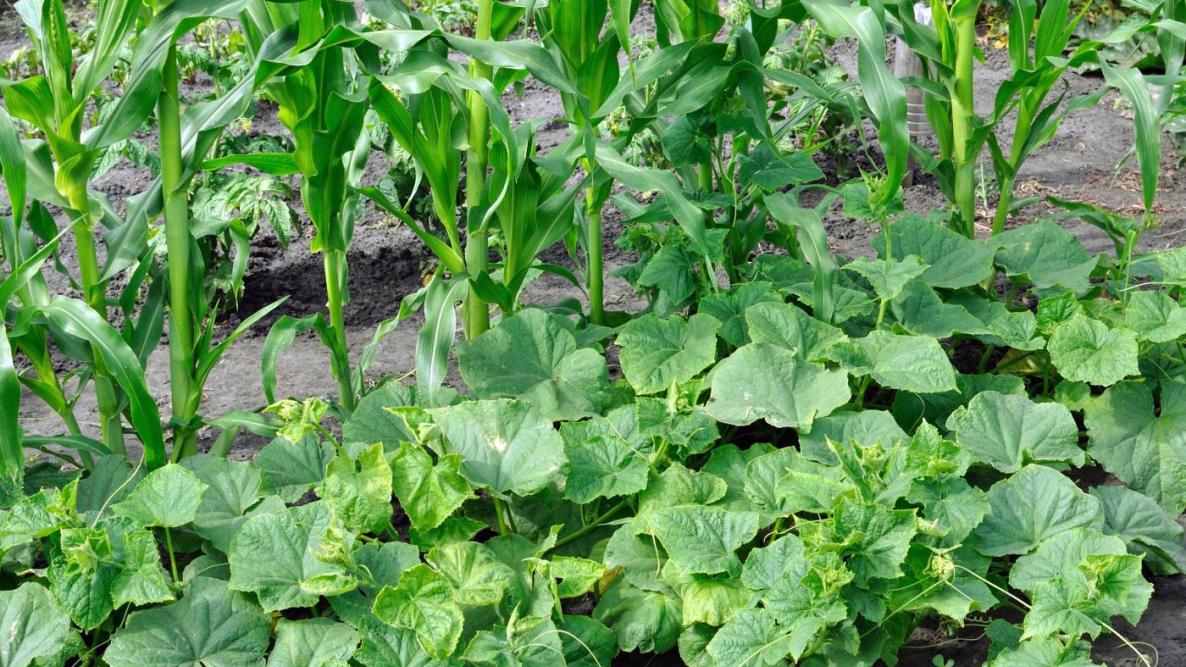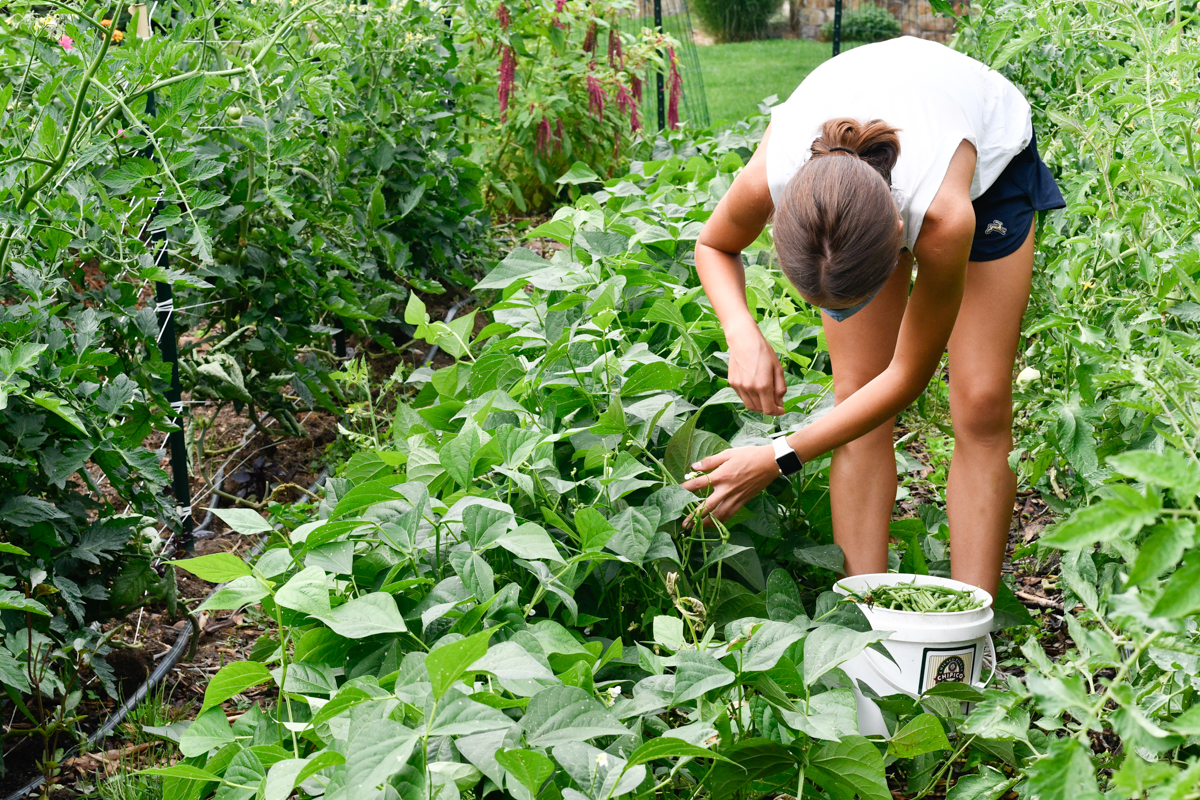Companion planting is the practice of growing different crops near one another to enhance crop production, repel damaging pests, improve soil health, and promote biodiversity.
Three Sisters Garden
Utilizing companion planting also helps maximize your garden space, by pairing different types of plants, like tall plants to provide shade to smaller plants, vining plants like squashes to help with weed suppression, and flowering plants to attract beneficial insects. A great example of companion plantings is ancestral The Three Sisters Garden or Milpa, which includes corn, beans and squash. The corn provides a natural support trellis and shelter for beans, peas and other climbing crops. In return, these legumes provide nitrogen to the soil for the corn and squash plants. Squash and pumpkin leaves shade the smaller bean and pea plants that need sun protection and provide weed suppression.

Here is a list of the most crops and their preferred companions:
| Vegetable | Plant with | Do not plant with |
| Beans | Potatoes, carrots, cucumbers, cauliflower, cabbage,
summer savory, most other vegetables and herbs |
Onions, garlic,
gladiolus |
| Beans, Bush | Potatoes, cucumbers, corn, celery, summer savory,
sunflowers, strawberries |
Onions |
| Beans, Pole | Corn, summer savory | Onions, beets,
kohlrabi, sunflower |
| Beets | Onions, kohlrabi | Pole beans |
| Cabbage Family (cabbage, cauliflower, kale,
kohlrabi, broccoli) |
Aromatic plants, potatoes, celery, dill, chamomile, sage, peppermint, rosemary, beets, onions, thyme, lavender | Strawberries, tomatoes, pole beans |
| Carrots | Peas, leaf lettuce, chives, onions, leek, rosemary,
sage, tomatoes |
Dill |
| Celery | Leek, tomatoes, bush beans, cucumbers, pumpkin, squash | |
| Corn | Potatoes, peas, beans, cucumbers, squash, pumpkin | |
| Cucumbers | Beans, corn, peas, radishes, sunflowers | Potatoes, aromatic
herbs |
| Eggplant | Beans | |
| Leek | Onions, celery, carrots | |
| Lettuce | Carrots and radishes (lettuce, carrots, and radishes
make strong team grown together), strawberries, cucumbers |
|
| Onion/Garlic | Beets, strawberries, tomato, lettuce, summer savory,
chamomile, beans (protects against ants) |
Peas |
| Parsley | Tomatoes, asparagus | |
| Peas | Carrots, turnips, radishes, cucumbers, corn, beans,
most vegetables, herbs (adds Nitrogen to soil) |
Onions, garlic,
gladiolus, potatoes |
| Potato | Beans, corn, cabbage, horseradish (should be
planted at corners of patch), marigold, eggplant (as a lure for Colorado potato beetle) |
Pumpkins, squash,
cucumber, sunflower, tomato, raspberries |
| Pumpkin | Corn | Potatoes |
| Radish | Peas, nasturtium, lettuce, cucumbers | |
| Soybeans | Grows with anything; helps everything | |
| Spinach | Strawberries | |
| Squash | Nasturtium, corn | |
| Sunflower | Cucumbers | Potatoes |
| Strawberry | Bush Beans | |
| Tomatoes | Chives, onion, parsley, asparagus, marigold, nasturtiums, carrots, limas | Kohlrabi, potatoes, fennel, cabbage |
| Turnip | Peas |
Here is a list of the most commonly planted herbs and their preferred companions
| Herbs | Companions and Effects |
| Basil | Companion to tomatoes; dislikes rue intensely; improves growth and flavor;
repels mosquitoes and flies. |
| Beebalm | Companions to tomatoes; improves growth and flavor. |
| Borage | Companion to tomatoes, squash, and strawberries; deters tomato worm;
improves flavor and growth. |
| Caraway | Plant here and there; loosens soil. |
| Catnip | Plant in borders; deters flea beetles. |
| Chamomile | Companion to cabbages and onions; improves growth and flavor. |
| Chervil | Radishes; improves growth and flavor. |
| Chives | Companion to carrots; improves growth and flavor; plant around base of fruit
trees to discourage insects climbing trunks. |
| Dill | Dislikes carrots; improves growth and health of cabbage. |
| Fennel | Plant away from the garden; most plants dislike it. |
| Garlic | Plant near roses and raspberries; deters Japanese beetle; improves growth and
health; plant liberally throughout the garden to deter pests. |
| Horseradish | Plant at corners of the potato patch to deter potato bugs. |
| Hyssop | Companion to cabbage and grapes; deters cabbage moth; keep away from
radishes. |
| Lamb’s Quarters | This edible weed should be allowed to grow in moderate amounts in the garden, especially in the corn. |
| Lemon Balm | Sprinkle throughout the garden. |
| Marigolds | The workhorse of the past deterrents; plant throughout garden especially with
tomatoes; it discourages Mexican bean beetles, nematodes, and other insects. |
| Mint | Companion to cabbage and tomatoes; improves health and flavor; deters white cabbage moth. |
| Marjoram | Plant here and there in the garden; improves flavor. |
| Nasturtium | Companion to tomatoes and cucumbers. |
| Petunia | Protects beans; beneficial throughout the garden. |
| Purslane | This edible weed makes good ground cover in the corn. |
| Pigweed | One of the best weeds for pumping nutrients from the subsoil, it is especially
beneficial to potatoes, onions, and corn; keep weeds thinned. |
| Rosemary | Companion to cabbage, bean, carrots, and sage; deters cabbage moth, bean beetles, and carrot fly. |
| Rue | Keep it far away from sweet basil; plant near roses and raspberries; deters
Japanese beetle. |
| Sage | Plant with rosemary, cabbage, carrots, beans, and peas; keep away from cucumbers; deters cabbage moth and carrot fly. |
| Summer Savory | Plant with beans and onions, improves growth and flavor; deters bean beetles. |
| Tansy | Plant under fruit trees; companion to roses and raspberries; deters flying insects,
Japanese beetles, stipend cucumber beetles, squash bugs, and ants. |
| Tarragon | Good throughout the garden. |
| Thyme | Plant here and there in the garden; it deters cabbage worms. |
| Yarrow | Plant along borders, paths, near aromatic herbs; enhances essential oil
production. |
Adapted from Organic Gardening and Farming, February 1972, pp. 32-33, 54, and The Encyclopedia of Organic Gardening, Rodale Press, Inc., 1978, pp. 233-235.




